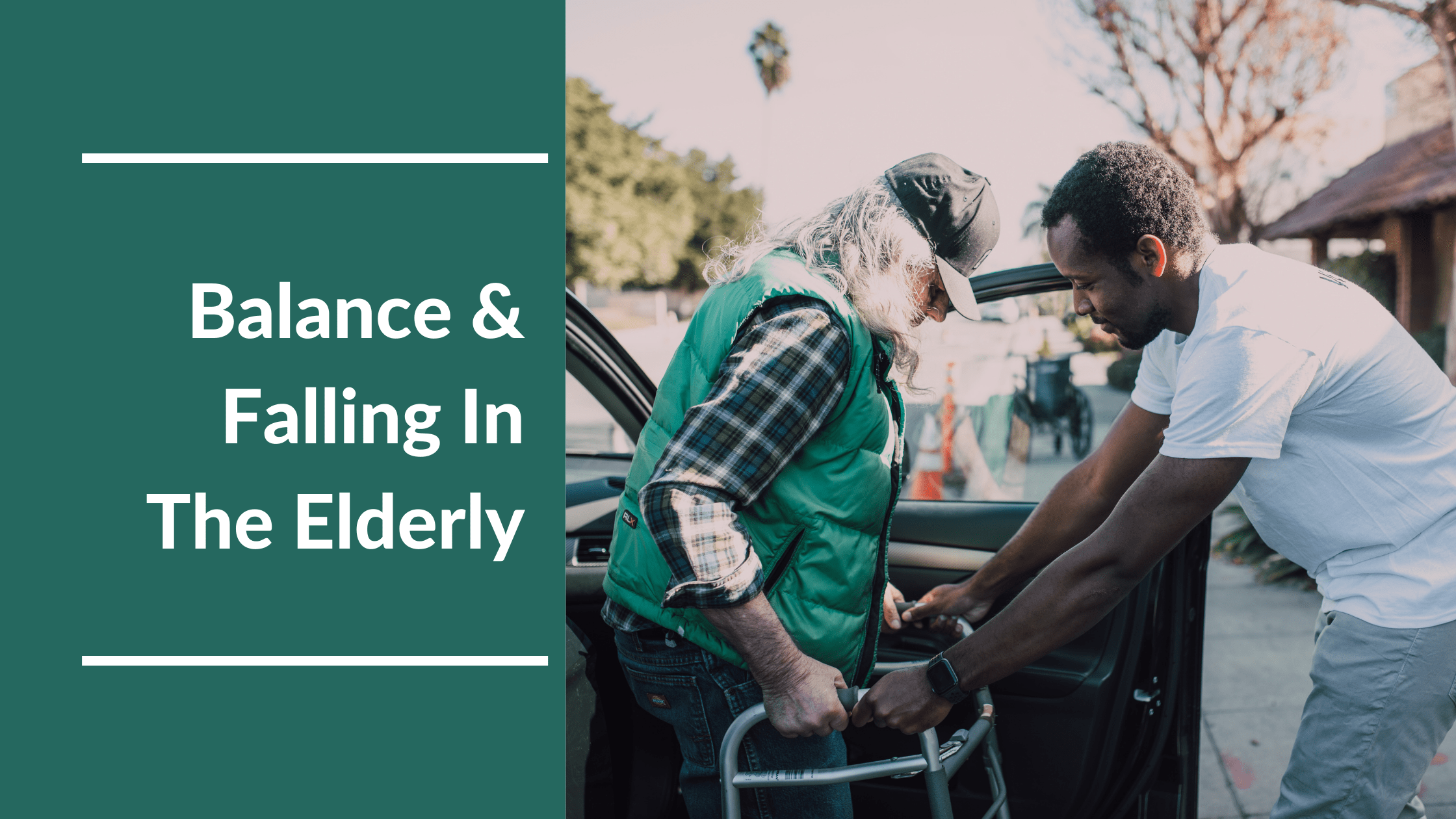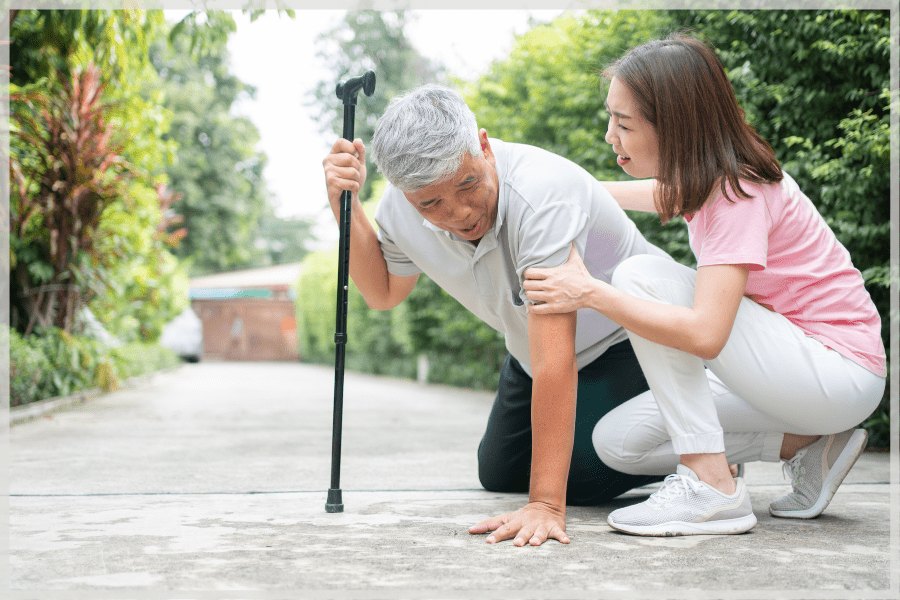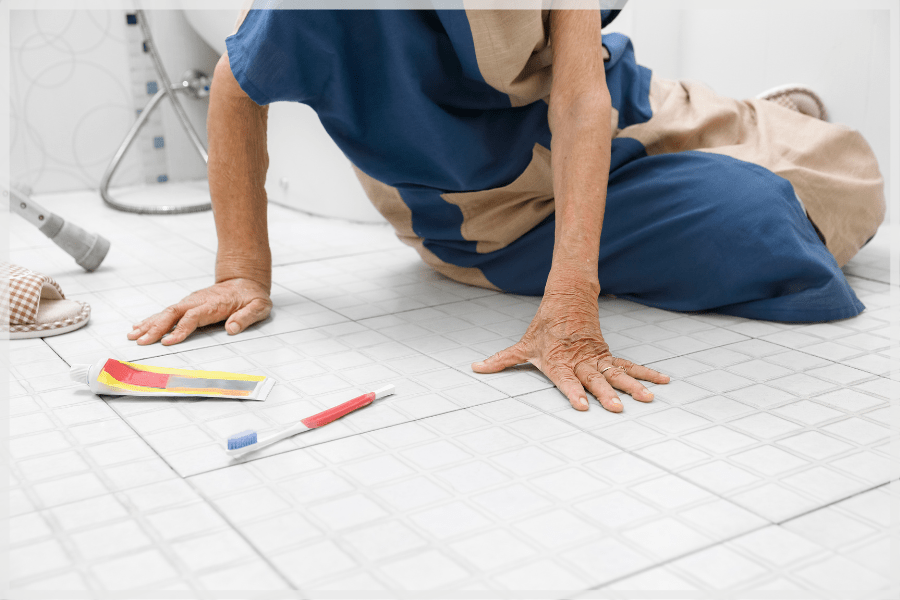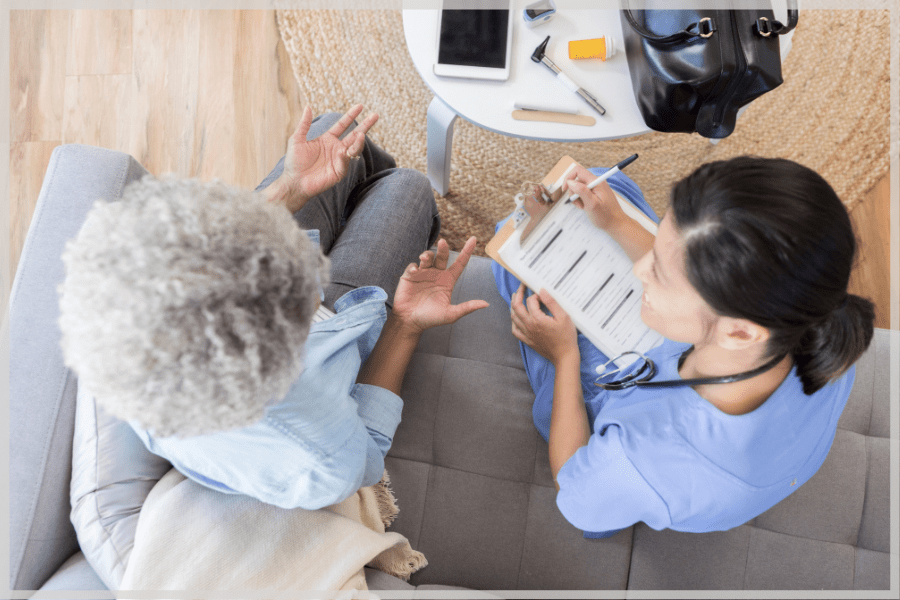
Falls can happen to anyone, anytime, anywhere. For this reason, learning how to keep seniors safe at home and understanding how to manage balance and falling in the elderly is essential.
Updated March 13, 2023
How To Manage Balance And Falling In The Elderly
In mid-July, 73-year-old Ivana Trump died in her home after an accidental fall. In an interview with the New York Post, a friend of the deceased told reporters that Trump had felt unwell for several weeks and could not “get out of her house” due to mobility issues. Despite these health concerns, Trump refused to seek medical attention for her condition.
Balance and falling in the elderly are among the most common reasons seniors seek medical assistance. Good balance is essential for wellbeing and quality of life because it promotes mobility, independence, the ability to perform activities of daily living (ADLs), and safety.
According to the National Institute on Aging (NIA), “good balance means being able to control and maintain your body’s position, whether you are moving or remaining still.” For example, balance prevents staggering when walking or falling when standing from a seat, bending over, or using the stairs.
Falls can happen to anyone, anytime, anywhere. For this reason, understanding how to manage balance and falling in the elderly is essential.
Facts About Balance And Falling In The Elderly
- Most traumatic brain injuries occur due to a fall
- Seniors who fall once are twice as likely to do so again
- 3 million older adults go to the ER yearly due to a fall-related injury
- At least 300,000 seniors are hospitalized for hip fractures each year
- 1 in 4 older adults falls annually, but fewer than half tell their physicians
- 1 in 5 falls results in serious injuries (broken bones, head injuries, etc.)
- Over 95% of hip fractures occur due to a fall, typically by falling sideways
- Annually, non-fatal fall injuries cost patients and insurers about $50 billion, while fatal falls cost around $754 million
- Annually, more than 800,000 hospitalizations occur due to falls (most commonly because of a head or hip injury)
What Causes Balance Problems In The Elderly?
Older adults are more likely to develop balance problems as they age, but that doesn’t mean aging is the only cause. Depending on the cause, some can lower the risk for specific balance issues.
Inner Ear Problems
In many cases, balance and falling in the elderly result from problems in the inner ear, a vital part of the body’s balance system. The vestibular system, or the labyrinth, is a part of the inner ear that controls balance.
Labyrinthitis develops if this part of the inner ear becomes infected or swells. When problems in the inner ear occur, it can cause dizziness and imbalance. Upper respiratory, viral, and bacterial infections can also cause labyrinthitis.
Neurological Conditions
Parkinson’s, multiple sclerosis, and other conditions increase the risk of balance and falling in the elderly. However, suppose your physician believes a more severe health problem causes your balance issues. In that case, they will seek a diagnosis and develop a course of treatment to manage them.

Circulatory System Issues
Stroke, low blood pressure, and other circulatory problems can lead to dizziness and other balance issues in the elderly. The body’s ability to effectively pump blood through the veins diminishes with age. As a result, sudden standing or moving can cause blood pressure to fall.
When this occurs, you may lose your balance briefly but recover as blood pressure normalizes. However, inefficient blood circulation can also slow oxygen’s ability to reach the brain, muscles, and other organs, which also contributes to feelings of periodic balance loss.
Medications
Many medications can cause balance issues, so a medical professional should address any symptoms. Antidepressants, anti-seizure drugs, sedatives, high blood pressure medications, and tranquilizers may cause or worsen balance and falling in the elderly.
Ask for alternative prescriptions, but if none are available, see if you can safely lower the dosage. If that isn’t an option, your doctor will help you find the proper treatment to relieve undesirable side effects.
Iron Deficiency
Iron is a critical nutrient that helps create new red blood cells, which move oxygen through the veins. Chronic low iron levels could be a symptom of anemia. People with anemia and struggle with balance may have pale skin and experience weakness.
Vitamin D Deficiency
Insufficient vitamin D levels reduce bone mineral density and strength. This weakness increases the risk of staggering, wobbling, and general instability while moving around, raising the chances of falling.
Low Blood Sugar
People who use insulin to manage their diabetes may experience dizziness during a sudden drop in blood pressure. They may also experience sweating or anxiety.
Vision Impairments
Impaired vision can increase seniors’ risk of falls by more than 50%. In one study, researchers found that older adults who were visually impaired reported higher instances of falls, fear of falling, and reduced activity.
Symptoms Of Balance Problems In The Elderly

Vertigo is a common symptom of balance problems in the elderly. Older adults with balance problems may stagger or fall when walking or standing. They may also experience different symptoms, such as:
- Blurry vision
- Unsteadiness
- Feelings of falling
- Dizziness or vertigo
- Lightheaded or faint
- Losing balancing and falling
- As if the room is spinning, even briefly
- Disoriented, lost sense of time, place, or identity
- As if you’re moving despite standing or sitting still
Other signs of balance problems could include:
- Diarrhea
- Nausea or vomiting
- Fear, anxiety, or panic
- Changes in heart rate and blood pressure
Symptoms may be intermittent and last for varying lengths of time. Talk to a medical professional immediately if you experience any of the above symptoms, which may cause fatigue and depression. A doctor may refer you to an otolaryngologist specializing in ear, nose, throat, head, and neck problems.
Treatment For Loss Of Balance In The Elderly
Not every fall leads to injury. However, for every five falls, at least one will result in a head injury, bone fracture, or other serious injuries. These injuries can severely impact older adults’ ability to move about, manage ADLs, or live independently.
Falls can have a severe psychological impact, too. A person who has fallen once often fears falling again, even if they didn’t injure themselves. This anxiety often compels a person to reduce their daily activities. However, when a person becomes less active, they usually become weaker, raising their risk of another fall.
Balance issues in older adults are a significant concern that a medical professional should address immediately. A doctor can help determine the cause of the problem and create a treatment plan. They can also decide whether or not it’s safe to drive and how to improve balance and avoid falling while using the stairs, the bathroom, exercising, or other daily activities.
Treatment for balance loss in older adults can vary depending on the cause of the problem. For example:
- Some balance issues can be symptoms of other health issues, such as an ear infection or stroke. Treating the condition causing the balancing problem in these cases will also ease balance issues.
- Consuming less salt and having a healthy lifestyle can improve balance issues due to high blood pressure.
- Staying hydrated, avoiding alcohol, and staying mindful of body posture and movements can help manage balance issues caused by low blood pressure.
Vestibular Rehabilitation Therapy
Unfortunately, some people may never wholly alleviate their dizziness. In these cases, the only option is to learn how to manage their condition. A vestibular rehabilitation therapist can help these individuals cope by creating a personalized course of treatment.
Exercises To Improve Balance In The Elderly
Some balance exercises require people to move the head and body in specific ways to help ease balance issues. A physical therapist can create an individualized exercise regimen based on particular needs and their knowledge of the balance system and its connection with the rest of the body.
Vision Exams
Older adults with vision problems should schedule annual eye exams and update their eyeglasses as needed. Additionally, seniors who wear bifocal or progressive lenses may consider glasses with just their distance prescription outdoors, as these lenses can distort object distance.
How Caregivers Can Help Manage Balance And Falling In The Elderly
Here are a few ways family and professional caregivers can help manage balance and falling in the elderly at home:
- Assess home safety
- Address potential underlying health conditions or concerns
- Check their balance when helping them sit, stand, or move around
- Make sure seniors schedule (and attend!) regular vision and health exams
- Encourage physical activity (take them to senior-friendly workout classes or exercise with them at home)
Home Modifications For Fall Prevention
According to the NIA, 6 out of every 10 falls occur in the home. Unfortunately, home is where many people spend most of their time and usually move about without considering their safety. Fortunately, many home modifications address issues with balance and falling in the elderly.
Doctors may recommend an in-home nurse, physical therapist, or occupational therapist after a fall. These professionals can perform a home safety assessment and suggest other changes to avoid future falls.
Bathrooms
- Use night lights
- Use non-slip strips or mats on any surfaces that could become wet
- Install grab bars within reach of toilets and inside and outside the shower and bathtub
Bedrooms
- Keep a phone close to the bed
- Use bed alarms for fall-risk patients
- Use night lights and place the bed near light switches
- Keep a flashlight near the bed in case of a power outage

Stairs, Halls, & Walkways
- Avoid throw or small area rugs
- Make sure you can see each step clearly
- Install handrails on both sides of the stairs and ensure they are secure
- Remove clothes, papers, shoes, wires, papers, and other clutter from walkways and stairs
- Ensure all carpets are secured to the floor so they won’t slide underfoot (fix non-slip strips to wood or tile floors)
- Use railings when using the stairs (if you have to carry something while using the stairs, use one hand to hold it and the other to hold the handrail)
- Use night lights to ensure stairs, halls, and walkways are well-lit (light switches should be easily accessible near the top and bottom of the stairs and at each end of the hallways)
Other Living Areas
- Avoid walking on newly mopped floors
- Fix carpets and large rugs securely to the floor
- Remove cords and telephone wires from walkways
- Keep a list of emergency contacts near each phone
- Keep frequently-used items somewhere easily accessible
- Be aware of pets when moving around to avoid tripping and falling
- Ensure sofas and chairs are high enough to get in and out of them safely
- Keep furniture and other items (specifically low coffee tables) out of walkways
- Don’t use chairs or tables to get out-of-reach items (ask for help, use a reach stick, and only use sturdy stepstools with handrails with someone nearby)
Resources To Help Manage Balance And Falling In The Elderly
Many state and local governments offer programs to help prevent problems with balance and falling in the elderly. Contact your health department or Area Agency on Aging to find programs near you. You can also reach out to these organizations for assistance:
MeetCaregivers Helps Manage Balance And Falling In The Elderly
Balance and falling in the elderly can seriously impede the ability to age in place, disrupting seniors’ and families peace of mind.
A professional caregiver can help remove barriers to aging in place by identifying fall risks, implementing prevention strategies, and reducing fall-related injuries. In addition, they support family caregivers who don’t always have the time for regular visits, ensuring seniors are cared for and safe.
MeetCaregivers wants to help more seniors receive quality care at home. To learn how we can help, call 1 (888) 541-1136 or find a caregiver today.
For more resources and information, visit our Blog.
Sources
- Cheema, M. R., & Chaudhry, A. (2016). Quality-of-life indicators and falls due to vitamin D deficiency. International Journal of General Medicine, 2016(9), 21–25. https://doi.org/10.2147/ijgm.s76360
- HIA Guest Blog. (2018, November 16). Having Poor Vision can Raise Risk for Falls Among Older Adults. HealthInAging.org. Retrieved July 21, 2022, from https://www.healthinaging.org/blog/having-poor-vision-can-raise-risk-for-falls-among-older-adults/
- IH National Institute on Aging. (n.d.). Balance Problems and Disorders. NIA.NIH.gov. Retrieved July 20, 2022, from https://www.nia.nih.gov/health/balance-problems-and-disorders. Content reviewed: May 1, 2017
- Living Assistance Services, Inc. (2017, August 23). How can Home Care Help Seniors Avoid Falls? VisitingAngels.com. Retrieved July 21, 2022, from https://www.visitingangels.com/knowledge-center/why-in-home-care/how-senior-home-care-can-help-prevent-problematic-falls-and-fractures/66
- NIH National Institute on Aging. (n.d.). Fall-Proofing Your Home. NIA.NIH.gov. Retrieved July 20, 2022, from https://www.nia.nih.gov/health/fall-proofing-your-home. Content reviewed: May 16, 2017
- Slisco, A. (2022, July 15). Ivana Trump’s Cause of Death Revealed as Friend Confirms Declining Health. Newsweek.com. Retrieved July 20, 2022, from https://www.newsweek.com/ivana-trumps-cause-death-revealed-friend-confirms-declining-health-1725200
- U.S. Department of Health & Human Services. (n.d.). Cost of Older Adult Falls. CDC.gov. Retrieved July 21, 2022, from https://www.cdc.gov/falls/data/fall-cost.html. Page last reviewed: July 9, 2020
- U.S. Department of Health & Human Services. (n.d.). Facts About Falls. CDC.gov. Retrieved July 21, 2022, from https://www.cdc.gov/falls/facts.html. Page last reviewed: August 6, 2021
- WebMD Editorial Contributors. (n.d.). Balance Issues in Older Adults: What You Need to Know and How to Address It. WebMD.com. Retrieved July 20, 2022, from https://www.webmd.com/healthy-aging/what-causes-balance-issues-in-older-adults. Reviewed by Dan Brennan, MD, on March 18, 2021
